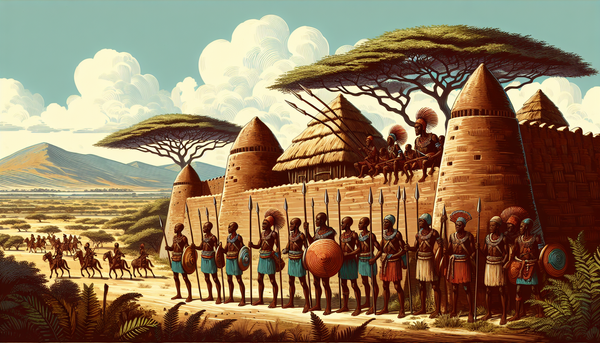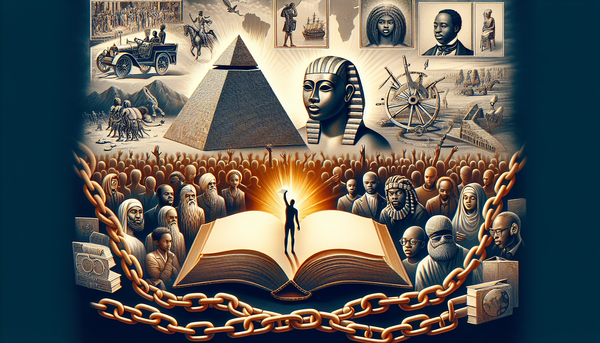The Transatlantic Slave Trade and Its Legacy

Introduction to the Transatlantic Slave Trade
The transatlantic slave trade, spanning over four centuries, stands as one of the most egregious and dehumanizing chapters in human history. Beginning in the 15th century, European powers established a brutal system of commerce that forcibly trafficked millions of Africans to the Americas to toil in plantations and mines under inhumane conditions.
Driven by economic motives and fueled by racism and exploitation, the transatlantic slave trade reshaped the socio-economic landscapes of Europe, Africa, and the Americas. African men, women, and children were captured, traded, and transported across the Atlantic Ocean in cramped and unsanitary conditions, enduring unimaginable horrors during the arduous journey known as the Middle Passage.
The transatlantic slave trade was a complex network of trade routes that connected European slave traders, African slave merchants, and colonial plantation owners in the Americas. Enslaved individuals were treated as commodities, stripped of their humanity, and subjected to brutal exploitation for the financial gain of their captors.
The impacts of the transatlantic slave trade were far-reaching and enduring, shaping the development of modern capitalism, fueling the growth of colonial economies, and perpetuating systems of racial oppression and inequality that continue to impact societies to this day. Understanding the historical origins and consequences of the transatlantic slave trade is essential for grappling with its legacy and working towards justice, healing, and reconciliation in the present.
Middle Passage: Harrowing Journeys Across the Atlantic
The Middle Passage, the nightmarish middle leg of the transatlantic slave trade, represented a harrowing ordeal for enslaved Africans as they were transported from Africa to the Americas. The journey, characterized by brutal conditions, overcrowding, and cruelty, was a traumatising experience that dehumanized and devastated the lives of millions.
Enslaved Africans, captured from various regions of the African continent, were packed into the cargo holds of slave ships like sardines, stripped of their dignity, and subjected to unimaginable suffering. Men, women, and children endured cramped and unsanitary conditions, with limited access to food, water, and fresh air. Disease, malnutrition, and extreme violence were rampant, resulting in high mortality rates among the captives.
The Middle Passage symbolized the callousness and ruthlessness of the transatlantic slave trade, as enslaved individuals were treated as mere commodities to be bought, sold, and transported for profit. The traumatic experiences endured by enslaved Africans during the Middle Passage left a lasting impact on their physical, emotional, and psychological well-being, perpetuating intergenerational trauma and suffering.
While the Middle Passage was a journey marked by horror and despair, it also served as a site of resistance and resilience for enslaved peoples. Despite the overwhelming odds stacked against them, some captives rebelled, fought back, and found ways to preserve their cultural traditions and humanity amidst the brutality of the slave ships.
The legacy of the Middle Passage serves as a somber reminder of the depths of human cruelty and the enduring resilience of the human spirit in the face of unimaginable suffering and adversity.
Economic Contributions: Wealth and Development in the New World
The transatlantic slave trade played a pivotal role in shaping the economic development of the New World, particularly in the Americas where enslaved Africans were exploited for their labor in agriculture, mining, and other industries. The forced migration and enslavement of millions of Africans fueled the expansion of colonial economies and the accumulation of immense wealth for European powers and American plantation owners.
Enslaved individuals were instrumental in the production of lucrative crops such as sugar, tobacco, cotton, and coffee, which were in high demand in global markets. The labor of enslaved Africans was essential for the profitability of plantations and mines, providing the foundation for the economic prosperity of colonial societies.
The wealth extracted from the exploitation of enslaved labor contributed to the growth of industries, infrastructure, and trade networks in the New World. Cities flourished, ports expanded, and new economic opportunities emerged as a result of the influx of capital generated by the transatlantic slave trade.
The economic contributions of enslaved Africans were profound and enduring, laying the groundwork for the industrial revolution and the modern capitalist system. The legacy of slavery as a foundation for economic prosperity in the New World is a stark reminder of the deep-seated inequalities and injustices that continue to shape global economic systems today.
Recognizing the economic contributions of enslaved individuals is essential for understanding the complex legacies of the transatlantic slave trade and addressing the ongoing disparities and injustices that persist in contemporary societies. Acknowledging the role of enslaved labor in shaping the economic wealth and development of the New World is crucial for confronting the historical injustices of slavery and working towards a more inclusive and equitable future.
Resistance and Rebellion: Acts of Defiance by Enslaved Peoples
Throughout the brutal history of the transatlantic slave trade, enslaved individuals demonstrated remarkable acts of resistance and rebellion in the face of oppression and dehumanization. Despite the extreme violence and repression they faced, many enslaved Africans refused to accept their subjugation and actively resisted their enslavers through various means.
Forms of resistance ranged from individual acts of defiance, such as feigning illness or sabotaging machinery, to collective rebellions and uprisings against plantation owners and overseers. Enslaved individuals employed strategies such as running away, forming maroon communities, and engaging in armed rebellions to challenge the authority of their oppressors and assert their humanity.
One of the most well-known acts of resistance was the Haitian Revolution, a successful slave rebellion that led to the abolition of slavery and the establishment of Haiti as the first independent black republic in the Western Hemisphere. Led by revolutionary figures such as Toussaint Louverture and Jean-Jacques Dessalines, enslaved Africans in Haiti fought courageously for their freedom and dignity, inspiring liberation movements around the world.
The legacy of resistance and rebellion by enslaved peoples serves as a testament to the strength, resilience, and agency of those who fought against the bonds of slavery. These acts of defiance not only challenged the oppressive systems of the transatlantic slave trade but also paved the way for future struggles for justice, equality, and freedom.
Understanding and honoring the stories of resistance and rebellion by enslaved individuals is essential for recognizing the agency and resistance of those who fought against insurmountable odds and injustice. Their courageous acts continue to inspire movements for liberation and social change, reminding us of the power of collective resistance in the face of oppression.
Global Abolition Movements: Struggles for Freedom
The brutal and inhumane practices of the transatlantic slave trade sparked widespread resistance and abolition movements around the world, as individuals and organizations fought tirelessly to end the institution of slavery and secure the freedom and rights of enslaved peoples. These movements emerged in various regions, mobilizing activists, abolitionists, and formerly enslaved individuals in a collective struggle for justice and liberation.
In the 18th and 19th centuries, abolitionist movements gained momentum in Europe and the Americas, fueled by moral outrage, humanitarian considerations, and demands for social justice. Activists such as William Wilberforce in Britain, Frederick Douglass in the United States, and Olaudah Equiano in Africa played pivotal roles in advocating for the end of slavery and the recognition of the inherent dignity and rights of all individuals.
The abolitionist movements were marked by a diversity of tactics, including political lobbying, grassroots organizing, and direct action campaigns to raise awareness about the injustices of slavery and mobilize public support for abolition. These efforts culminated in legislative victories, such as the abolition of the transatlantic slave trade and the emancipation of enslaved individuals in various countries.
The global abolition movements not only led to the formal abolishment of slavery but also paved the way for international human rights conventions and declarations that affirmed the universal principles of freedom, equality, and dignity for all. The legacy of these movements continues to inspire contemporary struggles for social justice and equality, underscoring the importance of collective action and solidarity in the fight against oppression and exploitation.
Recognizing the contributions and sacrifices of abolitionists and freedom fighters is essential for understanding the historical struggles for freedom and justice, and for honoring the enduring legacy of those who dedicated their lives to the abolition of slavery and the promotion of human rights for all.
Contemporary Repercussions: Social and Cultural Impacts
The transatlantic slave trade and the institution of slavery have left lasting and profound repercussions on contemporary societies, shaping social structures, cultural identities, and interconnected systems of inequality and injustice. The legacy of slavery continues to manifest in various forms, influencing attitudes, behaviors, and power dynamics in modern contexts.
Socially, the historical trauma of slavery persists in the form of intergenerational trauma, systemic racism, and disparities in access to resources and opportunities. The dehumanization and exploitation of enslaved Africans have contributed to enduring inequalities in wealth, education, healthcare, and criminal justice systems, disproportionately impacting marginalized communities.
Culturally, the legacies of the transatlantic slave trade are reflected in artistic expressions, cultural traditions, and collective memories that have been shaped by the experiences of enslaved peoples. From music and literature to cuisine and language, the cultural contributions of African descendants have enriched and influenced global cultures, challenging dominant narratives and celebrating resilience and creativity in the face of adversity.
Contemporary repercussions of the transatlantic slave trade also include ongoing debates about memory, reparations, and reconciliation. Efforts to reckon with the legacy of slavery have led to calls for truth and reconciliation commissions, memorialization projects, and educational initiatives aimed at confronting historical injustices and promoting healing and understanding among communities affected by the transatlantic slave trade.
Addressing the social and cultural impacts of slavery requires a collective effort to acknowledge the lasting consequences of historical injustices, confront systemic inequalities, and work towards building more inclusive and equitable societies. By recognizing the deep-rooted legacies of the transatlantic slave trade, communities can foster dialogue, reflection, and action towards creating a more just and compassionate world for current and future generations.
Conclusion: Reflections and Continuing Dialogues
The history of the transatlantic slave trade is a dark and haunting chapter in the collective memory of humanity, marked by unimaginable atrocities, resilience, and resistance. As we reflect on the legacies of this system of exploitation and brutality, it is imperative to engage in ongoing dialogues that acknowledge the lasting repercussions of slavery and strive towards justice, reconciliation, and healing.
The stories of enslaved Africans and their descendants serve as a poignant reminder of the enduring power of the human spirit in the face of inhumanity and oppression. Their acts of resistance, resilience, and cultural preservation continue to inspire movements for social change and liberation, underscoring the importance of recognizing the agency and dignity of all individuals in the struggle for equality and freedom.
Contemporary societies are grappling with the enduring impacts of the transatlantic slave trade, from systemic racism and economic disparities to cultural appropriations and historical erasures. By engaging in critical reflections, honest conversations, and proactive initiatives, we can begin to address the profound legacies of slavery and work towards building more just, inclusive, and equitable societies for all.
Continuing dialogues about the transatlantic slave trade require a commitment to truth-telling, reparative justice, and collective memory. By confronting the uncomfortable truths of our shared past and honoring the voices and experiences of those who suffered under slavery, we can sow the seeds of understanding, empathy, and solidarity that are essential for healing intergenerational wounds and forging a more compassionate and equitable future for all humankind.



